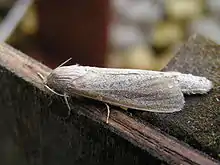Phragmataecia castaneae
Phragmataecia castaneae, the reed leopard or giant borer, is a moth of the family Cossidae.[1] It was described by Jacob Hübner in 1790. It is found in central and southern Europe, the Middle East, the Caucasus, Transcaucasia, Turkmenistan, Kazakhstan, north-western Iran, Iraq, Syria, Sri Lanka, Madagascar, India, Lebanon, Turkey, western China, south-western Siberia, Egypt, Tunisia and Morocco.[2]

| Reed leopard | |
|---|---|
 | |
_male_Danube_delta.jpg.webp) | |
| Scientific classification | |
| Kingdom: | |
| Phylum: | |
| Class: | |
| Order: | |
| Family: | |
| Genus: | |
| Species: | P. castaneae |
| Binomial name | |
| Phragmataecia castaneae (Hübner, 1790) | |
| Synonyms | |
| |
Description
As a genus, they lack palpi. Antennae of male bipectinated (comb like on both sides) to two-thirds of length where the braches are short. Legs are without spurs. Wings are long and narrow. The wingspan is 27–50 mm. Head, thorax and abdomen are brownish white. The female is larger than the male. The forewings are buffish grey with fine dark spotting. The female has a very long abdomen, which extends far beyond the wingtips at rest. Hindwings white or brownish white. In some specimens, the striations of the forewings are absent.[3] The body of the larva is yellowish white with two purplish-brown lines on the back. Head is light brown.
Ecology
The moth flies from May to July depending on the location. The larvae feed on Phragmites australis, Phragmites communis, Phragmites gigantea and Phragmites pumila.[4] After larva hatching in summer, it feeds first in shoot tips. After two moults, larva enter a base internode. Larvae pupate after two years within shoots.[5]
As a pest
Larva severely devastate the shoot tips. The point it emerges is completely eaten first through and few internodes below the growing point are packed with frass, results so called "dead heart". Feeding on shoot bases by more developed larva is indistinct. Leaves may yellow and wilt from shoot base.[5] They are known to attack Saccharum officinarum, Saccharum spontaneum and Sorghum propineum.
In control processes, seed cuttings are often treated with hot water at 50 °C for two hours. Dry leaves are removed before shipment when they moved to pest-free area. According to integrated pest management, pest resistant varieties are cultivated. In biological methods, Tumidiclava species can be introduced to the field, but it may be adapted to these predators.[6]
General references
- Skinner, Bernard (1984). Colour Identification Guide to Moths of the British Isles. Viking Press. p. 3. ISBN 0-670-80354-5.
- Waring, Paul; Martin Townsend (2003). Field Guide to the Moths of Great Britain and Ireland. British Wildlife Publishing. p. 22. ISBN 0-9531399-2-1.
References
- "Reed Leopard Phragmataecia castaneae". UKMoths. Retrieved 19 December 2011.
- Description of two new species of Cossidae (Lepidoptera) from China
- Hampson, G. F. (1892). The Fauna of British India, Including Ceylon and Burma: Moths Volume I. Taylor and Francis – via Biodiversity Heritage Library.
- Cossidae of Israel
- "The Reed Leopard". CABI Europe. Retrieved 13 July 2016.
- "Giant borer (Phragmataecia castaneae)". Plantwise Technical Factsheet. Retrieved 13 July 2016.